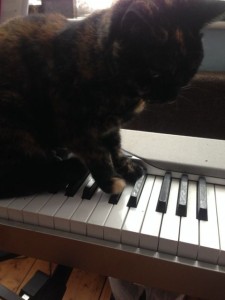Imagine – if you’re a dancer – that the curtain’s gone down on Act I, the house lights have gone up, and the audience are heading for the bar. You head for your dressing room. Suddenly, the stage manager brings the tabs out again and your director says “OK, now dance something really beautiful for the audience to leave the auditorium to.” That’s what it’s like when, at the end of the barre, just at the moment you think you can give your mind and hands a rest, and when everyone else has disengaged from class and music, the teacher wants you to play music for stretching.

First of all, you thought you were going to have a rest. It reminds me of that sketch when Dame Edna Everage decides to play a joke on her hospitalised husband by telling him he’s going home, going as far as to put him on a stretcher and get him into the ambulance outside the hospital, before screaming “April Fool!” and taking him back to the ward.
Then there’s the fact that you’ve been asked to play something “beautiful” just at the moment when nobody wants to listen. Some won’t stretch, some will leave the room, and those who do stretch could just as easily stretch without music, since there’s no actual exercise. You know for a fact that left to their own devices, if these dancers wanted music to stretch to, they’d put their headphones on and select something from their own music collection. Before you came to class, you deliberately avoided thinking of music that wasn’t in eight-bar phrases. Now, the teacher wants you to play something that makes people think of relaxing and stretching, of being distracted from pain and movement. What you need is music that doesn’t put you in “class” mode.
Years ago, I used to bring a few things with me for these moments – like the Rachmaninov Vocalise, or the 2nd movement of the Shostakovich 2nd piano concerto, but the fashion for asking for music for stretching has all but disappeared (and I’m rather glad) so it’s now a bit of a shock when it happens, and I’m not prepared. It’s not so bad if the teacher doesn’t put too much weight on it – I liked it recently when a ballet master looked over to me at the end of the barre, and made “playing the piano” movements with his hands while shrugging his shoulders, in a gesture that meant “Just play any kind of tinkly piano shit you like while they’re faffing around before the centre.” That’s fine. It’s when they close their eyes, cross their hands over their heart, and say “Something beautiful for stretch, maestro.” Thankfully, it hasn’t happened in a long time. Please don’t start now.
Update: Since writing this post, I started going to the gym. Like most gyms, mine plays a continuous selection of music to which I’m usually indifferent; but one day, while I was mid-plank, the music stopped. Inwardly, I screamed “TURN IT BACK ON! PLEASE! I DON”T CARE WHAT IT IS, TURN IT BACK ON!” I had always thought one of the teachers I work for was joking when she’d said “Play anything you like to take their [the children’s] minds off the pain.” Now I know she must have been deadly serious, because I’ve experienced it first-hand. So while I still hate playing music for stretching, for all the reasons I’ve mentioned above, I apologise for the misunderstanding, and of course, I’ll willingly play any kind of tinkly piano shit you like while you faff around before the centre.
PS: There’s a gratuitous cat on today’s post, because it’s St Lucy’s day, and Daria Klimentová’s cat is called Lucy. She featured on St Lucy’s day on last year’s St Lucy’s day post, with a free download of Santa Lucia for your Swedish Christmas ballet class.

